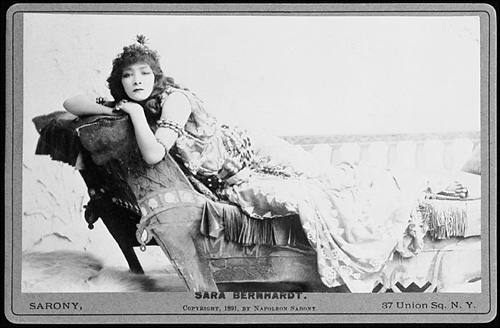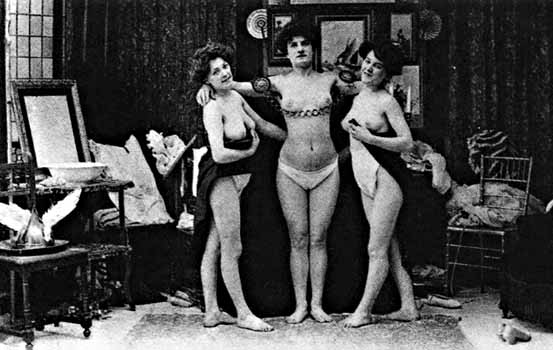Raymond Rudorff, Belle Epoque
Courtesans and Prostitutes
The great erotic legend of fin de siècle Paris was partly fostered by those who had a commercial interest in its propagation. It was incarnated in the persons of the great cocottes or grandes horizontales who carried on the traditions of the Second Empire courtesans. On a more frivolous level, the legend was encouraged and maintained by witty boudoir farces in the manner of Feydeau. In Paris and elsewhere, 1890-vintage eroticism was to a large extent a matter of stage setting and trappings. The cocotte or femme fatale had her place in society as long as she behaved in the manner expected of her, and she required appropriate surroundings to heighten her sexual fascination. A striking illustration of the mania for exotic decoration as a setting for sin is provided by the famous photographs of Sarah Bernhardt reclining in the midst of semi-Oriental luxury, against a stagy background of tiger skins, velvets and silk hangings, like a panther lying in wait for its prey in a claustrophobic, incense-heavy atmosphere. The age was one that was highly receptive to sexual suggestions. The fetish of the female leg, ankle and bosom which was so pronounced in the late 19th century, the frankness of well-known writers, and the florid, flowing lines of interior designs and furnishings which were to reach a paroxysm in the art nouveau style all played an important part in giving the French Nineties an aura of intense eroticism. The writings and theories of the "decadents" only reached a limited number of readers but their reputation had both shocked and fascinated a wider public. Their expressed desire to experiment with new sensations, their interest in what was bizarre and exotic and the fact that they seemed to be encouraging the individual to enrich his sensual experience through art, drugs, absinthe and unconventional behaviour encouraged belief in the moral wickedness of the Nineties. Such a tendency was by no means confined to France but it was Paris that had provided the centre for the "decadent movement". The innocent frolics at the Moulin Rouge and other places of entertainment, the publicity which was given to well-known courtesans, the frankness of singers, writers and caricaturists and a vague conception of Paris as the centre of a moral decadence encouraged by immoral artists and writers made the city appear a new Babylon to many curious foreigners. In addition, the growth of the Socialist movement, anti-clericalism and the apparent impunity with which artists and intellectuals flouted middle-class propriety dismayed many morally minded Parisians.

Sarah Berhardt as Cleopatra (1891)

Prostitutes in a Maison close

Henri de Toulouse-Lautrec, Salon de la rue des Moulins, (1894)
Prostitution was probably no more developed in Paris than it was in other cities of Europe. If the foyer of the Moulin Rouge or the promenade of the Folies Bergère was well attended by ladies of the town, so was that of the Empire music hall in London and many other places of entertainment in Vienna, Berlin and New York. But in Paris, street prostitution and maisons closes made their way into the folklore of the city. Foreign ideas of the depravity of the French seemed to be confirmed by Léo Taxil who declared that the licensed brothels of Paris were frequented by "the magistrature, the army, the navy, high finance, officials of the Republic, important men of business, members of the Jockey Club, foreign princes, visiting millionaires".
By 1889 the French brothel and the prostitute had become à la mode in "naturalistic" literature. In reality, the maison close was somewhat in decline, although only temporarily. In 1870, 145 such establishments were known to the Paris police but by 1880 the number had dropped to 110, and in 1888 there were only 73. In 1892, there were a mere 59 but by 1900 there had been a recovery and the large, illuminated street numbers of 127 maisons closes [“closed houses,” i.e. houses of prostitution] were a sign to visitors that Paris had other pleasures to offer than those of the great Exhibition of that year.
For the more discriminating roué or curious traveler there were a number of more select addresses to which he might pay a discreet visit. Some houses were so luxuriously appointed that they became famous as a new kind of Arabian Nights pleasure palace. Moralists of the day pointed out that touting for these establishments was becoming increasingly open and frequent. A single gentleman sitting at a pavement cafe could hardly sip his coffee undisturbed without some waiter, street urchin or passing cabbie slipping him a pink-tinted and often scented visiting card with a name followed by an address and the hint "tout confort" or "discretion assured". Some were more eloquent, promising such delights as "tableaux vivants" and all the refinements of "modern science".
The whole period, from the Eighties to the First World War, was a golden age for some Paris brothels which catered to a distinguished and cosmopolitan clientele. One of the best known, number 6, Rue des Moulins, was famous for being the home for a time of Toulouse-Lautrec who had painted each inmate in turn and boasted to friends that his address had a "very large street number. A very large number indeed." He had long been a frequent visitor to Paris brothels ever since he had first taken lodgings on the Boulevard de Clichy only a few yards away from the notorious Perroquet Gris which was demolished in 1892. His documentary turn of mind, the fascination that Paris popular and low life had for him, his deliberate rejection of his family background and his need for consolation for his deformity led him to some of the great Parisian maisons closes which be painted with as much enthusiasm as the circus or the music hall. He was not alone in depicting such subjects, for in 1899 the artist Georges Bottini held a well-attended exhibition of water colours of Bars et Maisons closes.